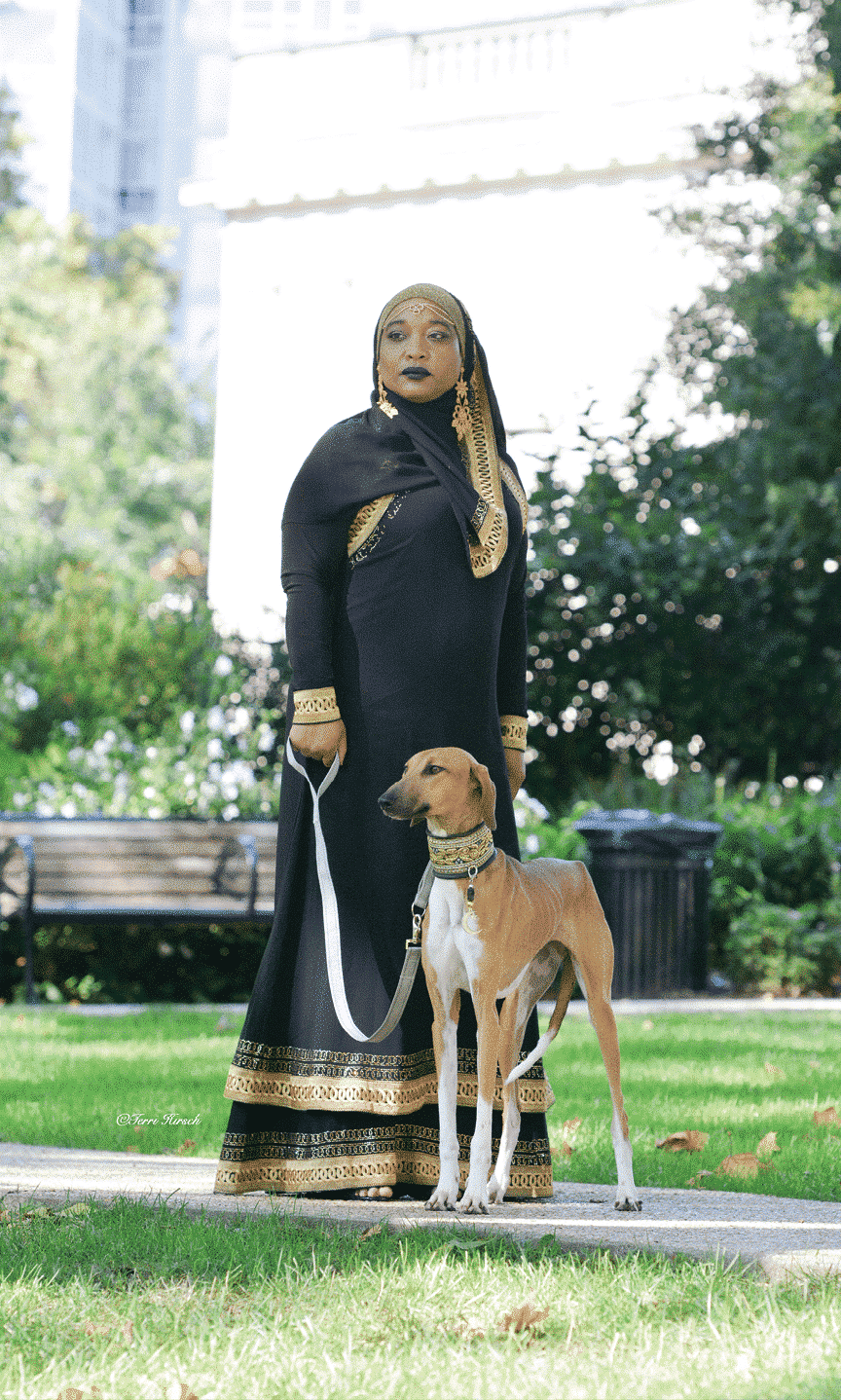Azawakh Interview with Aliya Taylor | Kel Imajaghan Azawakhs, talking about her interests, introduction with Azawakh dog breed, dog show experience and more.
1. Where do you live? What is your occupation? How many years in dogs?
I am a resident of Philadelphia. I have lived here for most of my childhood and adult life. I am a retired police officer. I was a police officer for the City of Philadelphia for 18 years before getting injured by an on-duty incident, and a stroke that followed.
I have always had a love for animals, and used to bring home injured wildlife to care for. I wanted to be a veterinarian as a child, but life happens and I didn’t get to realize that dream. I have been into dogs ever since I was a little girl, with my first dog being a Schnauzer; so for over 25-30 years. I showed him in small shows, and learned to hand-strip him myself at 13 from a book I’d read. My next dog, well into adulthood, was a Boston Terrier, which I bred once and had spayed after her whelping of the litter, due to complications. She had two puppies that went to the family. My next dog, many years later, was a Standard Poodle that I got, unfortunately, from a backyard breeder. I showed in UKC events until he died of Addison’s. I learned from that experience that a reputable breeder is the only way to go when looking for a purebred animal. I got hooked on Sighthounds with my first one, a Borzoi, which I showed limitedly in AKC events. He was my heart dog who introduced me to Sighthounds. He lived a long life for a Borzoi, passing away at 9 years old.

2. Do you have any hobbies or interests apart from purebred dogs?
Yes! I am a creative soul by heart. I have always been creative, and I have made African-inspired jewelry for myself and for others. And in just the last three years, I have created an online business called Mother Of Hounds. I make custom Sighthound collars and leashes, mostly in African print textiles. My store is on Etsy, called MotherOfHoundsDesign. I am in the process of building a website.
3. Can you talk about your introduction to the Azawakh?
My introduction to the Azawakh was one that was in the stars. I had a book in my teenage years called Dog Breeds of the World. It had almost every dog listed in it, including the Azawakh. It intrigued me that the Hound—back then they were calling it the Tuareg Sloughi—was from West Africa, particularly from the area where my ancestors are from. I have Hausa lineage, but it’s from the northern part of Nigeria where my people are from. The Hausa kept Azawakh as well. Years later, into my adulthood, I met the breeder of my first Azawakh, David Moore, on Facebook. That was the first time I saw Azawakh outside of a book—and real people had them. I was excited to finally find someone I could get one from. (My first Azawakh’s name is Toumour wa n’Tafouk, which means “Toumour who comes from the sun” in the Tamasheq language of the Tuareg people.) That was also when I decided on a kennel name, should I decide to breed one day. I chose the name “Kel Imajaghan” to honor the people who keep the Azawakh, the Tuareg. The name means “of the proud and free.” The Imajaghan were the elite warrior class of the Tuareg/Tamasheq who were charged with protection of the village.
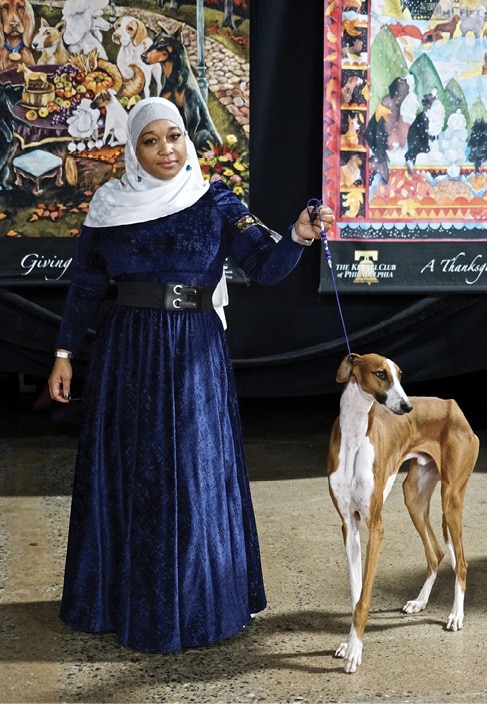
4. The Azawakh is a genuine canine original. What makes the breed so intriguing?
The Azawakh breed is a genuine canine original. The Azawakh is an African Sighthound that originated in the countries of Mali, Burkina Faso, and Niger. They are raised in the Sahel region of the Sahara Desert, and they are named after the Azawagh Valley. The Azawagh is mainly made up of Sahelian and Saharan flatlands, and has a population that is predominantly Tuareg, with some Arabic-speaking, Bouzou, and Wodaabe minorities, and a recent influx of Hausa and Zarma. They are still used, to a certain extent, to function as a guard dog first and foremost. They are used to hunt, but it’s a secondary function of the breed. They are also very reliable off-lead if they are trained early in puppyhood. (They are the only Sighthounds to have this distinction.) Due to war and food insecurities in the area, they are becoming rare. I love them because of their aloof nature—an almost wild, catlike demeanor—and their absolute devotion to their “people.” They bond very closely to those whom they choose to accept. They are like living art, and I am honored to live with them.
5. What about the breed’s unique body/height proportion of 9/10?
The unique body proportions of 9:10 are a result of evolution. In the area of West Africa where they are from, almost all the animals have that same body ratio; taller than long (camels, goats, and cattle in the region). My unscientific observation is that it’s an adaptation to the heat of the region. Long legs, to keep the internal organs cool, help the animal to travel long distances at a trot with their nomadic owners.
6. Can you describe the Azawakh’s “impression of great fineness?”
The “impression of great fineness” comes from the body morphology of the Azawakh. Since it is a desert-dwelling animal, an abundance of fat would not be beneficial for the dog’s staying cool and being able to carry out its function. A leggy and elegant breed, the Azawakh’s bone structure and musculature are “transparent” beneath the skin and tissue. The breed has flat musculature like their human equivalent, the marathon runner.
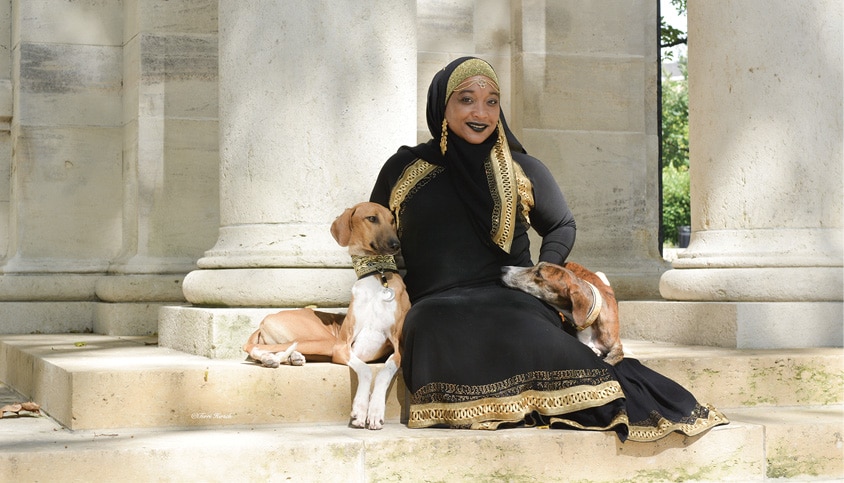
7. The AKC standard reads, “Color and markings are immaterial.” Care to elaborate?
Color and markings are immaterial: In the countries of origin, the Azawakh comes in an array of colors and patterns. No pattern is favored over another. As long as the dog can do its job, and function, color is immaterial to the people who keep them. Color does not “make” a dog. Some colors are more uncommon than others, however. Some Azawakh puppies, just imported to the US, are very dark. At least two that I know of look black, but are actually, genetically, a dark brindle. The others are black and white. Black is a recessive in the breed.
The very first Azawakh to leave Africa were originally imported to Europe, and they were almost all shades of red. Since the arrival of the Azawakh in the US, a breed standard for the AKC and UKC has been written to reflect the fact that the breed comes in any color and pattern, and all are able to be shown in conformation. Unfortunately, the FCI standard for the breed does not reflect this, and restricts the patterns and coat colors of the Azawakh.
8. The standard describes how the Azawakh walks, trots, and gallops. Why the detail on movement?
The standard focuses so much on the gait because of the morphology of the breed. Because of its shape, the angles of the Azawakh are open. The length of the body is 90 percent of the height of the hound; and this can be slightly higher in females. Shoulders are long, lean, and muscular, and only slightly slanting when seen in profile. The scapulo-humeral angle is very open (about 130 degrees). The breed is, essentially, a standing rectangle. Taken from the standard: “The Azawakh’s movement is agile and light, without hackney action or pounding. He has particularly graceful, elastic movement at the walk. The trot gives the appearance of floating effortlessly over the ground. At the trot, the front foot should not extend past the end of the nose. The gallop is leaping. The movement is an essential point of the breed.” There is no TRAD (tremendous reach and drive). The closest comparison that I can give as to the gait of an Azawakh at an easy trot is that of a Thoroughbred horse. The breed, when structured and moved correctly, should float with an easy fluidity; in my imagination, as water gently licking the shore of a beach. At a gallop, the Azawakh’s leaping gait is because of the ratio of the body; 9:10. It’s the most efficient movement at a gallop for traversing the terrain in the countries of origin, which are a mix of desert, rocky terrain, and grassland in some places where the breed is found.
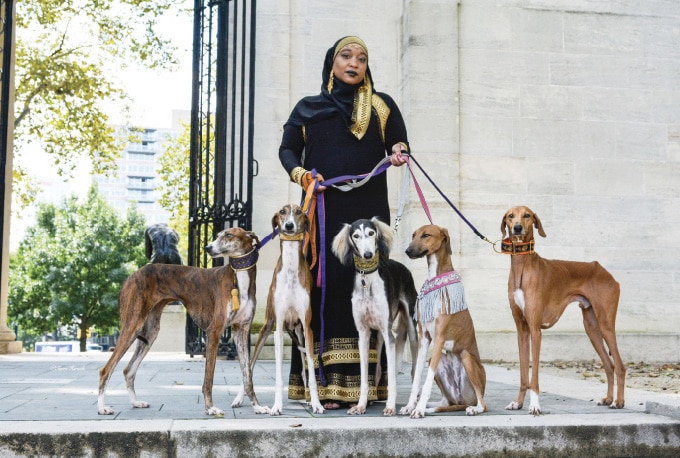
9. What’s it like to live with an Azawakh? Does the breed bark, shed, need a lot of exercise?
Living with this breed is understanding that it will not act like a Golden Retriever. They will not like everyone you invite into your home, including family that doesn’t visit often. They are a guard dog, first and foremost. They will bark at strangers, be avoidant, and will not appreciate random touching. If you respect the boundaries of the Azawakh, and not force interaction with those whom it doesn’t know, you will have a stable companion. I tell guests to ignore the dog, and let it come to you. Eventually, the inquisitive nature of the Azawakh will win out, and they may approach with a quick sniff. If you continue to ignore, they will see that as an invitation to investigate further. With calm movements and a calm voice, they will settle down—but will still be watchful of any strange company that stops by. With people they know, Azawakh are very friendly and affectionate. Mine rub on people they know like cats. They play bow and smile!
They are moderate shedders, and simply keeping up with a three times a week brushing schedule will suffice with shedding hair. They also don’t have much of a smell. The only time I bathe my Azawakh fully is when they are attending a show and need to be “tip-top” or when they’ve gotten into something dirty or stinky. I do daily wipe-downs on my dogs and
spot bathing.
Exercise is normal with this breed. They don’t require a mandatory block of exercise; daily walks and time to free-run are ok. They love heat, and will walk and run without much effort in hot weather. They would be good for people who like to run, and hike. They will have their moments of “zoomies” but settle down for naps most of the day. I take mine out to a fenced-in park several times a week to blow off steam when the weather is good. In cold weather, a few of mine wear coats, but the majority take a coat as insulting and refuse to move! Since the coat of the Azawakh is so thin, just keep a watchful eye to make sure they don’t get too chilled.
10. For whom would you suggest the breed is best suited? Anyone who shouldn’t have one?
I would suggest this breed to experienced dog owners who have intimate experience with Sighthounds and guard dog-type breeds. They are not for the first-time dog owner unless extensive research is done on the temperament, and the Azawakh’s unique physiology. Some owners don’t understand the unique body structure of the breed, and attempt to feed it more. This is not good. A fat Sighthound of any breed will not be as healthy as one in correct weight. Since its format is so fine, extra weight may adversely affect its joints.
It’s been a trend as of late to have dogs as “service dogs.” The Azawakh is not suited for this kind of work because of its aloof and avoidant character. There are a few individuals that are service animals, but it’s not the norm for the breed; I do not recommend it.
11. Do you show your dogs in Conformation? Performance or Companion events?
I do show my dogs in Conformation. Since COVID, shows have been few and far between. I was stricken with COVID in the very beginning of the pandemic, so no shows for that time. I am finally starting back up with conformation myself, and have attended some lure coursing events to get my younger dogs keen for the lure. In the meanwhile, I have hired a handler to show my newest show prospect that I got from Finland. The import’s name is Bahir, (Ingenue Idanse Bollinger) and I expect great things from him! He is also the sire of the litter I have on the ground now out of a bitch I bred from my first litter over five years ago. Her name is Kel Imajaghan Auhainah, and she was the second dog I showed to its CM (Certificate of Merit) in the Miscellaneous Class, before full recognition by the AKC. These puppies will be the future of Kel Imajaghan. I am looking to improve on height, so I am optimistic that this breeding has done that for my line. I have also shown my first Azawakh to his CM, and another female I have at my home who was the dam of my first litter. I also have a little bitch whom I co-bred with a friend and co-owner, Deb Kidwell. Deb’s been in the breed since the 1980s and she has a wealth of information that I go to time and time again. Our bitch’s name is (Umoya) Kel Simoon Umoya n’Imajaghan. I just got her AKC S.T.A.R. Puppy certification, which is a step towards the Canine Good Citizen certificate. I plan on doing lots of activities with her in the future, like Rally and Obedience as well as Conformation.
I also co-own another bitch from a litter from two years ago, named Kel Imajaghan Jedediah, who has attained her Championship.
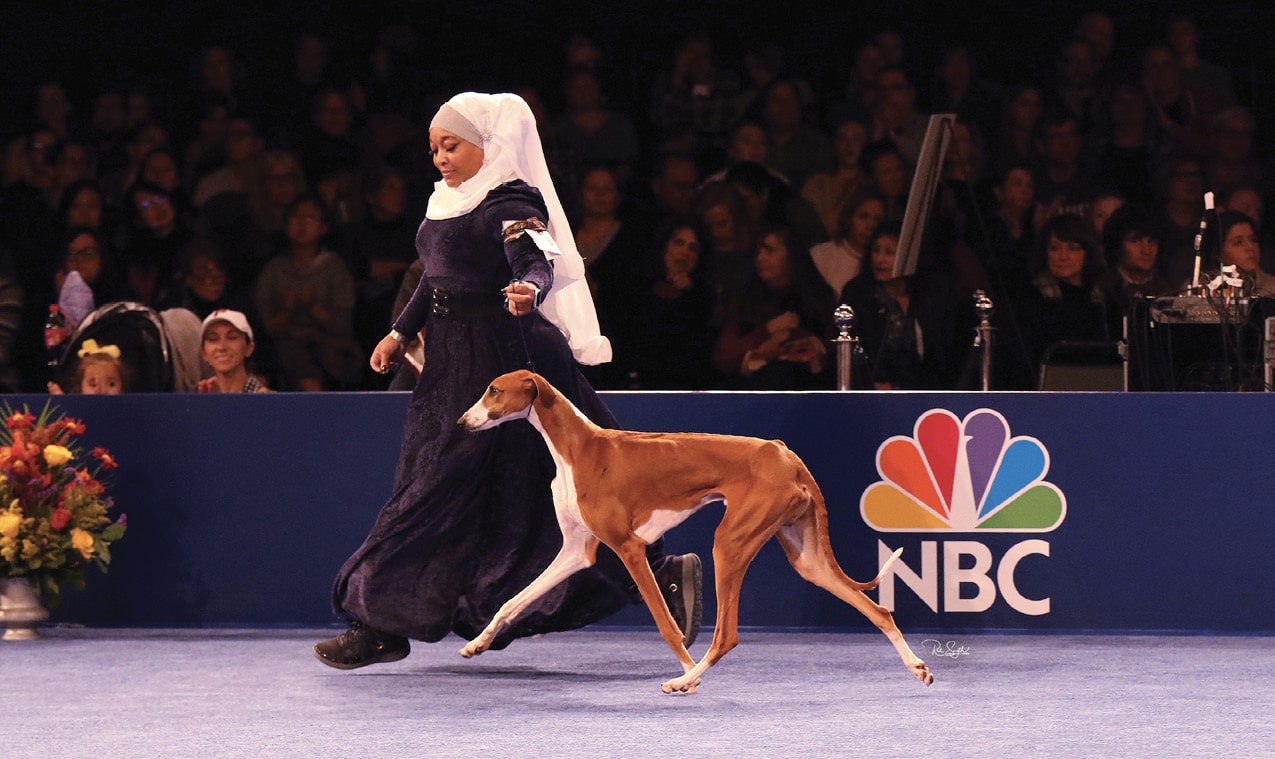
12. Is there a funny story you can share about your experiences with the Azawakh?
It’s a kinda funny story, I suppose. It was when I showed my dog, Bahir, for the first time in a big show, which happened to be the National Dog Show in 2019. He had only limited showing experience—and I asked a lot from him that day. We were the first to introduce the Azawakh at the National Dog Show. I was nervous, but I tried to keep my cool in the ring. Bahir, being an Azawakh, young and true to his nature, decided that he wanted to hide in the folds of the dress I had on. We were on national television, and I had to pick up his back end and straighten him out so that the judge could examine him. (He was just a year old that Thursday!) We got over the momentary snag, and we showed beautifully in the ring. We both survived! I was very proud of him that day. He’s now an “old hat” at showing and enjoys his time in the ring with his AKC registered handler and good friend,
Bekki Pina.
Another story was when I was walking a few of my Azawakh in Fairmount Park. A woman was driving past and yelled out her window something that I couldn t make out. She looped back around and parked her vehicle on the curb, and asked me if I were royalty because I looked like a princess walking those exotic dogs! Since I am a practicing Muslim, I wear the traditional headscarf called a hijab. I also had on a loose pink and black dress. She said we looked like something out of a high-end magazine, and she asked about the breed. It was refreshing to talk with someone who didn’t comment on how skinny the dogs were, and instead, just focused on their beauty. Mash’Allah.



